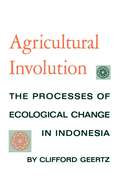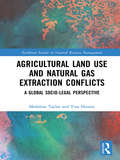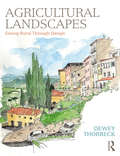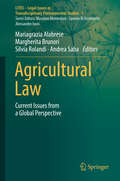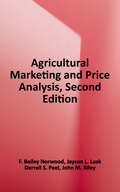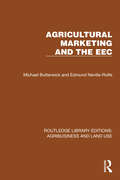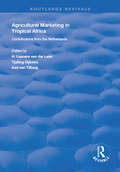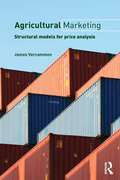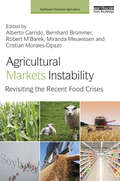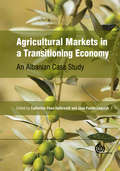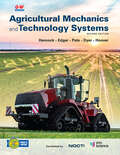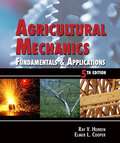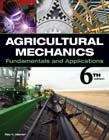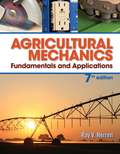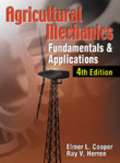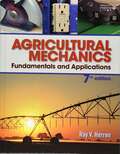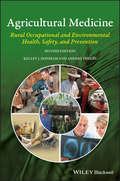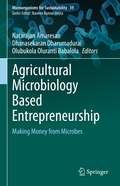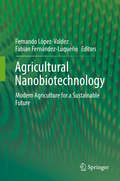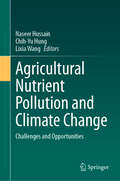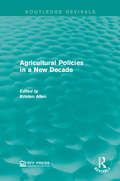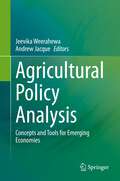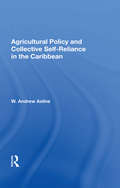- Table View
- List View
Agricultural Involution: The Processes of Ecological Change in Indonesia
by Clifford GeertzAgricultural Involution: The Processes of Ecological Change in Indonesia is one of the most famous of the early works of Clifford Geertz. It principal thesis is that many centuries of intensifying wet-rice cultivation in Indonesia had produced greater social complexity without significant technological or political change, a process Geertz terms "involution".Written for a US-funded project on the local developments and following the modernization theory of Walt Whitman Rostow, Geertz examines in this book the agricultural system in Indonesia and its two dominant forms of agriculture, swidden and sawah. In addition to researching its agricultural systems, the book turns to an examination of their historical development. Of particular note is Geertz's discussion of what he famously describes as the process of "agricultural involution" in Java, where both the external economic demands of the Dutch rulers and the internal pressures due to population growth led to intensification rather than change.
Agricultural Land Use and Natural Gas Extraction Conflicts: A Global Socio-Legal Perspective (Earthscan Studies in Natural Resource Management)
by Madeline Taylor Tina HunterOnshore unconventional gas operations, in most jurisdictions, operate on the legal principle that all activities during exploration and extraction are ‘temporary’ in nature. The concept that the onshore unconventional gas industry has a temporary effect on the land on which it operates creates a regulatory paradox. On one hand, unconventional gas activities create energy security, national wealth and a bourgeoning export industry. On the other, agricultural land and agriculturalists may be significantly disadvantaged by unconventional gas activities potentially producing permanent damage to non-renewable fertile soils and spoiling the underground water tables. Thus, threatening future food security and food sovereignty. This book explores the socio-regulatory dimensions of coexistence between agricultural and onshore unconventional gas land uses in the jurisdictions with the highest concentration of proven unconventional gas reserves – Australia, Canada, the USA, the UK, France, Poland and China. In exploring the differing regulatory standpoints of unconventional gas land uses on productive farming land in the chosen jurisdictions, this book provides an original three-part categorisation of regulatory approaches addressing the coexistence of agricultural land and unconventional gas namely: adaptive management, precautionary and, finally, statism. It offers a timely and topical approach to socio-legal natural resource governance theory based on the participation, transparency and empowerment for agricultural landholders, examining how differing frameworks such as the collective bargaining framework can create equitable and sustainable contractual arrangements with unconventional gas companies.
Agricultural Land Use: Structural Transformations, Environment Challenges, Planning and Policy (Earthscan Food and Agriculture)
by Jerzy BańskiThis book presents contemporary trends and challenges in agricultural land use, drawing on an array of global case studies.This volume examines agricultural land use through a three-pronged approach: structural transformations, environmental challenges, and planning and policy. Reflecting the global relevance of contemporary challenges to agricultural land use, the book presents a wide range of novel case studies from across the world, including Poland, Hungary, Denmark, Slovenia, Czechia, Tanzania, Uganda, South Africa, Algeria, Northeast Africa countries, China, India, Australia, New Zealand, USA, and Brazil. Each chapter focuses on a particular issue related to agricultural land use in that country or region, including land fragmentation, reduction of crop land, agricultural intensification, desertification of soils, climate change, biodiversity loss, traditional agricultural systems, urbanization and rural development, and planning challenges for agricultural land. Together the chapters present a global view of the challenges facing the agricultural industry and offer solutions for developing sustainable agricultural practices to ensure food security and environmental and biodiversity conservation.This book will be of great interest to students and scholars of food and agriculture, land use and land management, rural studies, and sustainable development.
Agricultural Landscapes: Seeing Rural Through Design
by Dewey ThorbeckAgricultural Landscapes: Seeing Rural Through Design follows on from the author’s previous books, Rural Design and Architecture and Agriculture, to encourage using design thinking to provide greater meaning and understanding of places where humans live and work with the rural landscape. Rural areas around the world are often viewed as special places with cultural, historical and natural significance for people. Dewey Thorbeck emphasizes the importance of these rural sites and their connections to urban areas through full-color case studies of these places with particular emphasis on Globally Important Agricultural Heritage Systems (GIAHS), as identified by the UN Food and Agriculture Organization, to document and explore personal experiences, lessons learned, and implications for the future. Rural landscapes are part of everyone’s heritage, and the book shows these connections and the unique GIAHS land use systems and landscapes as models for a more sustainable and prosperous rural and urban future. It includes practical examples of working places where growing food, raising animals, or harvesting from the sea has been the primary economy for centuries to exhibit a clear and sustainable local relationship between humans, animals, buildings, climate and place. Aimed at students, teachers and professionals, this book investigates how design thinking can be used to integrate rural and urban sites to shape land use for more sustainable futures.
Agricultural Law: Current Issues from a Global Perspective (LITES - Legal Issues in Transdisciplinary Environmental Studies #1)
by Mariagrazia Alabrese Margherita Brunori Silvia Rolandi Andrea SabaThis book focuses on the social and environmental issues being addressed by agricultural law within the current globalised system. What is agricultural law? Agricultural regulations concern and affect essential human needs and values that must be dealt with by pursuing a comprehensive and coordinated global approach. By tracking the developments in this context, this book explores the new challenges that agricultural law needs to address in order to frame emerging dilemmas. International governance of natural resources and their role in addressing food insecurity is the object of the first Part of the volume, which deals with sustainable agriculture and agro-ecosystem services in connection with the food security issue. The second Part focuses on the regulation of food as the main product of agricultural activity, and explores the answers that the law can provide in order to accommodate consumers' interests and concerns (inter alia, novel foods, animal welfare, direct sales and e-commerce). The third Part examines the social, environmental and legal consequences of a renewed interest in agricultural investments. Further, it analyses the evolution and the interplay between different legal systems with regard to land tenure, environmental concerns and investments in agriculture.
Agricultural Marketing and Price Analysis
by F. Bailey Norwood Jayson L. Lusk Derrell S. Peel John M. RileyFriendly and readable, this text presents a comprehensive approach to agricultural price analysis, market structures, and marketing strategies. The authors engage students with very little exposure to economics and with only a basic grasp of algebra. The text utilizes a fresh approach and supplies thorough coverage of core topics, as well as complex topics such as general equilibrium models, game theory, and econometrics. It also provides an introduction to data analysis and incorporates many examples. Supplemental materials are available for additional practice and further exploration. Unique to the Second Edition is the inclusion of a chapter on consumer behavior and food preferences, as well as relevant areas of research. The authors introduce readers to the agricultural supply chain, including forecasting and inventory management. Succinct and approachable, this text sets the stage for an enjoyable and effective learning experience.
Agricultural Marketing and the EEC (Routledge Library Editions: Agribusiness and Land Use #1)
by Michael Butterwick Edmund Neville-RolfeOriginally published in 1971, this book resulted from a 2-year study of the implications of the Common Market agricultural policy in relation to agricultural marketing in Britain. It provides the background to agricultural policies and explains why marketing developed differently in Britain and European countries. There are specific chapters on cereals, sugar, diary produce, horticultural products, livestock and meat, vegetable oils and oilseeds, eggs and poultry-meat and other farm products such as hops potatoes and wool). The book discusses such issues as the possible effects on British agricultural and horticultural marketing of adopting the CAP and the role played by the producer organisations.
Agricultural Marketing in Tropical Africa: Contributions of the Netherlands (Routledge Revivals)
by Aad Van Tilburg H. Laurens van der Laan Tjalling DijkstraFirst published in 1999, this volume explores how African agriculture has always had a strong appeal for the people of the Netherlands. This is due to (1) a long-established interest in tropical agriculture going back to the days when Indonesia was a Duth colony; (2) a broad-based desire to help the Third World; and (3) the view that Tropical Africa is highly dependent on agriculture. As practical expertise in Africa and systematic research on African agriculture grew, specialization became both possible and necessary. This volume reflects the specialization in marketing which has been welcomed by economists, geographers and scholars of agricultural marketing. In addition to a general introductory chapter, this book includes five contributions on staple food grains, two on export crops, two on cattle and one on horticulture. Nine of the chapters are country-specific, covering Benin, Burkina Faso, Cameroon, Cȏte d’Ivoire, Ghana, Kenya, Sierra Leone, Tanzania and Zambia.
Agricultural Marketing: Structural Models for Price Analysis
by James VercammenThe price of food has become very volatile in recent years for a variety of reasons, including a strengthened connection between the prices of agricultural commodities and other commodities such as oil and metals, more volatile production due to more frequent droughts and floods, and a rising demand for biofuels. Understanding the determinants of agricultural commodity prices and the connections between prices has become a high priority for academics and applied economists who are interested in agricultural marketing and trade, policy analysis and international rural development. This book builds on the various theories of commodity price relationships in competitive markets over space, time and form. It also builds on the various theories of commodity price relationships in markets that are non-competitive because processing firms exploit market power, private information distorts commodity bidding, and bargaining is required to establish prices when the marketing transaction involves a single seller and buyer. Each chapter features a spreadsheet model to analyze a particular real-world case study or plausible scenario, and issues considered include: the reasons for commodity price differences across regions the connection between the release of information and the rapid adjustment in a network of commodity prices the specific linkage between energy and food prices bidding strategies by large exporters who compete in import tenders The simulation results that are obtained from the spreadsheet models reveal many important features of commodity prices. The models are also well suited for additional "what if" analysis such as examining how the pattern of trade in agricultural commodities may change if shipping becomes more expensive because of substantial increase in the world price of oil. Model building and the analysis of the simulation results is a highly effective way to develop critical thinking skills and to view agricultural commodity prices in a rigorous and unique way. This is an ideal resource for economics students looking to gain develop skills in the areas of Agricultural Marketing, Commodity Price Analysis, Models of Commodity Markets, Quantitative Methods and Commodity Futures Markets.
Agricultural Markets Instability: Revisiting the Recent Food Crises (Earthscan Food and Agriculture)
by Alberto Garrido Robert M'Barek Bernhard Brümmer Miranda P. Meuwissen Cristian Morales-OpazoSince the financial and food price crises of 2007, market instability has been a topic of major concern to agricultural economists and policy professionals. This volume provides an overview of the key issues surrounding food prices volatility, focusing primarily on drivers, long-term implications of volatility and its impacts on food chains and consumers. The book explores which factors and drivers are volatility-increasing and which others are price level-increasing, and whether these two distinctive effects can be identified and measured. It considers the extent to which increasing instability affects agents in the value chain, as well as the actual impacts on the most vulnerable households in the EU and in selected developing countries. It also analyses which policies are more effective to avert and mitigate the effects of instability. Developed from the work of the European-based ULYSSES project, the book synthesises the most recent literature on the topic and presents the views of practitioners, businesses, NGOs and farmers' organizations. It draws policy responses and recommendations for policy makers at both European and on international levels.
Agricultural Markets in a Transitioning Economy
by Jean Fantle-Lepczyk Catherine Chan-HalbrendtThis book presents major challenges and opportunities facing agriculture sectors in the wake of the transition from a planned to market economy. Using Albania as a case study, it examines the shift from communism to free markets and the lasting effects of such change on agricultural production and education. Using primary research sources to give readers an accurate portrayal of the path that lies ahead for many developing countries, the book also looks at the future of agriculture in transitioning economies.
Agricultural Markets in a Transitioning Economy: An Albanian Case Study
by Jean Fantle-Lepczyk Catherine Chan-HalbrendtThis book presents major challenges and opportunities facing agriculture sectors in the wake of the transition from a planned to market economy. Using Albania as a case study, it examines the shift from communism to free markets and the lasting effects of such change on agricultural production and education. Using primary research sources to give readers an accurate portrayal of the path that lies ahead for many developing countries, the book also looks at the future of agriculture in transitioning economies.
Agricultural Mechanics and Technology Systems
by Dyer Hoover Pate Hancock EdgarAgricultural Mechanics and Technology Systems presents focused, technically accurate coverage of all major skilled trade disciplines in agricultural contexts, including construction, electricity, welding, and power systems. In addition, the text provides a wealth of information and resources on careers in agricultural mechanics and promotes a deep understanding of supervised agricultural experiences (SAEs) and career development events (CDEs). The second edition has been updated with over 500 new images and 35 new Career Connection features to portray up-to-date tools, technologies, and career opportunities. A chapter on Precision Agriculture and Emerging Technologies introduces students to the many high-tech applications, including geographic information systems (GIS), telematics, sustainable energy sources, precision agriculture, wireless sensor networks, and the use of drones.
Agricultural Mechanics: Fundamentals & Applications
by Ray V. HerrenA text for students learning basic mechanical skills in high school and postsecondary programs in agriscience, production agriculture, agribusiness, ornamental horticulture, and agricultural mechanics. Treatment begins with information on careers, then provides instruction on basic mechanical skills and applications. Covers use of hand tools, power tools, and stationary power equipment with numerous materials, touching on processes of wood- and metalworking, electric and gas welding, electrical wiring, robotics, plumbing, and construction. Includes color photos of male and female students, and 54 project plans. This fourth edition is revised to reflect the latest developments in the field. Annotation c. Book News, Inc., Portland, OR (booknews.com)
Agricultural Mechanics: Fundamentals & Applications
by Ray V. HerrenA text for students learning basic mechanical skills in high school and postsecondary programs in agriscience, production agriculture, agribusiness, ornamental horticulture, and agricultural mechanics. Treatment begins with information on careers, then provides instruction on basic mechanical skills and applications. Covers use of hand tools, power tools, and stationary power equipment with numerous materials, touching on processes of wood- and metalworking, electric and gas welding, electrical wiring, robotics, plumbing, and construction. Includes color photos of male and female students, and 54 project plans. This fourth edition is revised to reflect the latest developments in the field. Annotation c. Book News, Inc. , Portland, OR (booknews. com)
Agricultural Mechanics: Fundamentals and Applications
by Ray V. HerrenThis trusted text provides a thorough introduction to agricultural mechanics, covering fundamental mechanical and engineering theory, common tools and materials, and a wide range of practical applications. Units explore essential topics such as career opportunities, shop orientation and procedures, woodworking and metal working, tool fitting, project planning, cutting and welding, paints and paint application, power mechanics, electrical wiring, plumbing, hydraulics, concrete and masonry, and agricultural structures. Safety is also emphasized strongly throughout the text, both within each chapter and in a dedicated unit. To engage today's students and make even complicated principles easier to apply, the text features abundant, full-color images, illustrations, charts, and data tables, as well as detailed drawings of over 50 complete project plans. More than 300 of these visuals have been added or updated for the Seventh Edition, which also boasts a suite of dynamic digital teaching resources, such as an online Coursemate with lecture materials, videos, interactive quizzes, and more. The new edition also includes updates to reflect the latest innovations in materials, machinery, and methods, providing a current and comprehensive guide to help students plan and execute agricultural projects effectively.
Agricultural Mechanics: Fundamentals and Applications (4th Edition)
by Elmer L. Cooper Ray V. HerrenA text for students learning basic mechanical skills in high school and post-secondary programs in agriscience, production agriculture, agribusiness, ornamental horticulture, and agricultural mechanics. Treatment begins with information on careers, then provides instruction on basic mechanical skills and applications. Covers use of hand tools, power tools, and stationary power equipment with numerous materials, touching on processes of wood- and metalworking, electric and gas welding, electrical wiring, robotics, plumbing, and construction. Includes color photos of male and female students, and 54 project plans. This fourth edition is revised to reflect the latest developments in the field.
Agricultural Mechanics: Fundamentals and Applications, Updated: Precision Exams Edition
by Ray V. HerrenBeyond providing a thorough introduction to the field of agricultural mechanics, the Precision Exams Edition of this trusted text aligns to Precision Exams Agricultural Systems Technology, Level 1 exam. The text covers fundamental mechanical and engineering theory, common tools and materials, and practical applications including shop orientation and procedures, woodworking and metalworking, tool fitting, project planning, cutting and welding, paints and paint application, power mechanics, electrical wiring, plumbing, hydraulics, concrete and masonry, and agricultural structures. Safety is also emphasized strongly throughout the text, and a dedicated unit introduces students to diverse career opportunities. The current edition also features new information on the National FFA Organization and SAEs, first aid, and engine powered equipment, as well as new activities and lab exercises.
Agricultural Medicine: Rural Occupational and Environmental Health, Safety, and Prevention
by Kelley J. Donham Anders ThelinNewly updated, Agricultural Medicine: Rural Occupational Health, Safety, and Prevention, Second Editionis a groundbreaking and comprehensive textbook and reference for students and practitioners of public health, and professionals in the field of rural agricultural occupational health and safety. The book introduces specific occupational and environmental health and safety issues faced by agricultural workers and rural residents, and provides a roadmap to establishing sustainable worker and public health support in agricultural communities. Responding to reader demand, Agricultural Medicine, Second Edition now features more case studies, key point summaries, and new international perspective chapters comparing North American health and agricultural practices to those in Europe, the Asia Pacific, and South America. Agricultural health and safety engages a multidisciplinary team of medical professionals, veterinarians, safety professionals, engineers, sociologists, epidemiologists, and psychologists, for whom this book serves as an essential resource.
Agricultural Microbiology Based Entrepreneurship: Making Money from Microbes (Microorganisms for Sustainability #39)
by Olubukola Oluranti Babalola Natarajan Amaresan Dhanasekaran DharumaduraiThis book is first part of the 3 volume set focusing on basic and advanced methods for using microbiology as an entrepreneurial venture. This volume explains the entrepreneurship skills for production, cost-benefit analysis and marketing of bio-fertilizers, bio-pesticides, bio-insecticides, seaweed liquid biofertilizer, and phosphate solubilizers. Chapters cover the applications of microorganisms in small and large scale production to achieve a sustainable output. The book provides essential knowledge and working business protocols from all related disciplines in agribusiness, organic farming, and economic integration. This book is useful to graduate students, research scholars and postdoctoral fellows, and teachers who belong to different disciplines via Botany, Agriculture, Environmental Microbiology and Biotechnology, Plant Pathology, and Horticulture. Next two volumes are focused on food and industrial microbiology.
Agricultural Nanobiotechnology: Modern Agriculture for a Sustainable Future
by Fernando López-Valdez Fabián Fernández-LuqueñoNanobiotechnology in agriculture is a new knowledge area that offers novel possibilities to achieve high productivity levels at manageable costs during the production and merchandising of crops. This book shows us how we can use the cutting-edge knowledge about agriculture, nanotechnology, and biotechnology to increase the agricultural productivity and shape a sustainable future in order to increase the social welfare in rural areas and preserve the environmental health. Specialists from several countries will provide their feedback on a range of relevant topics such as environment-friendly use of nanofertilisers, nanodevices, nano-food packaging, nanocoating and nanocarriers and their relationship with the modern agriculture.
Agricultural Nutrient Pollution and Climate Change: Challenges and Opportunities
by Lixia Wang Naseer Hussain Chih-Yu HungThis book presents a comprehensive exploration of advanced scientific techniques for reducing agricultural nutrient pollution in the context of climate change. It delves into the sources, pathways, and extent of nutrient release into the environment, offering stakeholders valuable insights into how scientific advancements can help reduce environmental footprints. The authors critically examine key knowledge gaps, policy interventions, and challenges related to nutrient management from agrochemicals, synthetic fertilizers, and organic manures. As the demand for safe, sustainable, and environmentally friendly agricultural practices grows in the face of climate change, this book synthesizes scientific research, reports, and policies. It provides reliable information for scientists, students, policymakers, and organizations to promote effective nutrient utilization in agriculture while minimizing environmental impacts.
Agricultural Policies in a New Decade (Routledge Revivals)
by Kristen AllenAgricultural Policies in a New Decade was written in preparation for the 1990 Farm Bill in the United States in collaboration with the Food and Agriculture Committee of the National Planning Association. Originally published in the same year, this study aims to inform on the key issues affecting the new bill including budget austerity, the effects of agriculture on environmental quality, the safety and security of the U.S. food supply and international markets and trade policy. This title will be of interest to students of Environmental Studies and policy makers.
Agricultural Policy Analysis: Concepts and Tools for Emerging Economies
by Jeevika Weerahewa Andrew JacqueThis book is centred around various interwoven topics which are fundamental to policy analysis in agriculture. Key concepts and tools that are fundamental for the analysis of agricultural policies and programmes are presented. Key concepts introduced include, the role of the state in a market economy with examples from the Sri Lankan and other developing economies, the international trade environment, and conceptual frameworks for analysing important domestic and international trade policies. It also highlights interconnections among agriculture, development, policy and illustrates the extent to which the agricultural sector contributes in achieving economic growth objectives, equity and equality objectives and environmental objectives. The book takes the readers through the nature of agricultural markets in developing countries, with special emphasis on Sri Lanka, and illustrates how the degree of competitiveness is measured at various market levels using multiple indices and methods. Several tools, with accompanying case studies, for the analysis of policies and programmes are detailed. These tools include the GTAP model, gravity models, extended benefit cost analysis, and linear programming. Tools and models are applied to the analysis of trade policies and agreements, marketing policies, environmental services, extension programmes, land tenure reforms and climate change adaptations. Case studies in relation to the agri-food policy and strategy response to COVID-19 Pandemic are also covered. This book is of interest to public officials working in agricultural planning and agricultural policy, teachers, researchers, agro-economists, capacity builders and policymakers. Also the book serves as additional reading material for undergraduate and graduate students of agriculture, development studies, and environmental sciences. National and international agricultural scientists, policy makers will also find this to be a useful read.
Agricultural Policy And Collective Self-reliance In The Caribbean
by W. Andrew AxlineFocusing on the process of agricultural policy-making within the Caribbean Community and Common Market (CARICOM), this book provides a context for understanding the evolving theory of regional integration among developing countries. Dr. Axline traces the progress of Caribbean integration from its beginnings in the mid-1960s to its present state of stagnation. Drawing on original documents and extensive interviews in the twelve CARICOM member countries, he describes the move away from a market-oriented laissez-faire approach to agriculture and the shift toward sectoral programming. The role of other regional organizations, such as the Caribbean Development Bank and the Caribbean Agricultural Research and Development Institute, is examined and related to national and regional policies in the agricultural sector. The Caribbean experience, concludes Dr. Axline, suggests that the future direction of regional cooperation among developing countries will likely be toward more intensive integration on a less extensive scale.
